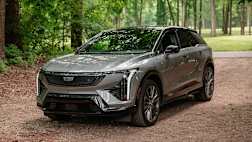If your knowledge of batteries extends about as far as “I’m pretty sure the TV remote takes double-As”, the world of electrified vehicles - hybrids, plug-in electric vehicles (PHEVs) and pure electric vehicles (EVs) - and the batteries they use may all seem a bit foreign.
For those new to the subject, it’s actually quite easy to get your head around.
Hybrids and PHEVs use both a traditional petrol-powered internal-combustion engine (ICE) and a battery-powered electric motor, although there are some key differences (an EV, of course, only has the battery-powered electric motor, and no ICE).
A hybrid battery is smaller, self-charging, and typically doesn’t allow for all-electric driving mode, whereas a PHEV has a larger battery that has to be connected to an external power source to charge, and it CAN drive in all-electric mode.
Hybrids are seen as a bridge between a traditional ICE vehicle and an EV, offering both the benefits of an electric motor (better fuel consumption, a reduction in harmful tailpipe emissions), and an ICE (a trusty back-up should the hybrid’s battery run out of charge).
A major concern for drivers when it comes to EVs is range anxiety - the worry you’ll run out of charge and be left with nowhere to plug it in, possibly sobbing quietly - so a hybrid provides a happy medium by providing a petrol-powered ICE to extend the range far beyond what the battery pack for the car provides on its own.
Petrol stations are also somewhat more common than charging ones.
There are also a few drawbacks of hybrids worth mentioning.
The ICE and electric motor in a hybrid need to be smaller to both fit in the vehicle, meaning they’re independently less powerful than larger versions. They also create more weight and take up more space in the car, sometimes creating less cabin or boot space, and result in the hybrid costing more than a standard ICE vehicle.
Examples of hybrids that are for sale in Australia include the Honda Accord Hybrid, Toyota Camry Hybrid and Hyundai Ioniq Hybrid.
Hybrid car battery: how it works

Like standard petrol-powered vehicles, hybrid cars have a 12-volt lead-acid battery and an ICE, with a battery-powered electric motor, although it’s common to see hybrids come with two electric motors as well.
The “battery” is, more accurately, a lithium-ion battery pack, as it contains hundreds - and sometimes thousands - of smaller lithium-ion batteries.
Unlike a PHEV, this battery pack is self-charging and the charging occurs via a process called regenerative braking, where kinetic energy that’s created when the hybrid brakes is either stored in the battery pack for later use, or used to directly power the wheels.
The battery pack can also be charged by the ICE when it’s either active during driving, or idling.
How far can hybrid cars go on batteries alone, and at what speed do hybrid cars switch from battery power to petrol power?
A hybrid battery switches seamlessly between the ICE and the electric motor to deliver maximum performance and delivery, and typically it can operate in all-electric mode, relying solely on the battery, at speeds of up to 40km/h, and for distances of around 2km. No, that’s not a lot, is it?
Because a PHEV’s battery pack is larger, it requires charging via an external power source, like a wall socket or public fast-charger. The increase in size means an increase in all-electric driving range, which is on average around 50km.
How long do hybrid car batteries last?

It’s no secret that in EVs and hybrid cars, battery degradation can be a problem that impacts battery life.
Battery packs are usually guaranteed by the car manufacturer for eight years or 160,000km - whichever comes first - and during that period of time, hybrid drivers will start to notice a decline in the battery pack’s ability to hold a charge.
When it comes to hybrid cars, this means more reliance on the vehicle’s ICE, which negatively impacts the car’s fuel efficiency and increases harmful tailpipe emissions.
Battery packs in hybrids can be replaced, but if the car is over three years old, it’s often seen as an uneconomical choice to purchase a replacement, rather than just buying a whole new car.
Can hybrid car batteries be recycled?
.jpg)
There are specialist technicians in Australia who are able to remanufacture used hybrid batteries and resell them at 60-80 per cent of the original cost, and Toyota, a leader in hybrid technology with its popular Prius model, has a hybrid battery recycling program that keeps 98 per cent of the battery materials out of landfill.
To sweeten the deal, Toyota offers $100 for the return of used hybrid batteries, or $500 off the price of a replacement battery.
That’s not a bad deal, although it’s worth remembering that hybrid batteries from third-party manufacturers are often cheaper than what’s available to purchase from a dealership.






.jpg)
.jpg)

.jpg)

.jpg)

.jpg)





.jpg)


.jpg)
